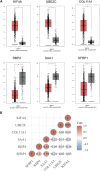A Novel Five-Gene Signature Related to Clinical Outcome and Immune Microenvironment in Breast Cancer
- PMID: 35646102
- PMCID: PMC9136328
- DOI: 10.3389/fgene.2022.912125
A Novel Five-Gene Signature Related to Clinical Outcome and Immune Microenvironment in Breast Cancer
Abstract
Breast cancer (BC) is the most frequent cancer in women and the main cause of cancer-related deaths in the globe, according to the World Health Organization. The need for biomarkers that can help predict survival or guide treatment decisions in BC patients is critical in order to provide each patient with an individualized treatment plan due to the wide range of prognoses and therapeutic responses. A reliable prognostic model is essential for determining the best course of treatment for patients. Patients' clinical and pathological data, as well as their mRNA expression levels at level 3, were gleaned from the TCGA databases. Differentially expressed genes (DEGs) between BC and non-tumor specimens were identified. Tumor immunity analyses have been utilized in order to decipher molecular pathways and their relationship to the immune system. The expressions of KIF4A in BC cells were determined by RT-PCR. To evaluate the involvement of KIF4A in BC cell proliferation, CCK-8 tests were used. In this study, utilizing FC > 4 and p < 0.05, we identified 140 upregulated genes and 513 down-regulated genes. A five-gene signature comprising SFRP1, SAA1, RBP4, KIF4A and COL11A1 was developed for the prediction of overall survivals of BC. Overall survival was distinctly worse for patients in the high-risk group than those in the low-risk group. Cancerous and aggressiveness-related pathways and decreased B cell, T cell CD4+, T cell CD8+, Neutrophil and Myeloid dendritic cells levels were seen in the high-risk group. In addition, we found that KIF4A was highly expressed in BC and its silence resulted in the suppression of the proliferation of BC cells. Taken together, as a possible prognostic factor for BC, the five-gene profile created and verified in this investigation could guide the immunotherapy selection.
Keywords: Kif4A; biomarker; breast cancer; immune cell infiltration; signature.
Copyright © 2022 Yang, Liu and Liu.
Conflict of interest statement
The authors declare that the research was conducted in the absence of any commercial or financial relationships that could be construed as a potential conflict of interest.
Figures








Similar articles
-
KIF4A on TGF-Β1/Smad3 Pathway: A Preliminary Investigation on the Proliferation and Immune Response in In-Vitro Cultured Breast Cancer Cells.Comb Chem High Throughput Screen. 2024 Dec 26. doi: 10.2174/0113862073356925241122055343. Online ahead of print. Comb Chem High Throughput Screen. 2024. PMID: 39757619
-
Integrative transcriptional characterization of cell cycle checkpoint genes promotes clinical management and precision medicine in bladder carcinoma.Front Oncol. 2022 Aug 11;12:915662. doi: 10.3389/fonc.2022.915662. eCollection 2022. Front Oncol. 2022. PMID: 36033441 Free PMC article.
-
A novel 12-gene prognostic signature in breast cancer based on the tumor microenvironment.Ann Transl Med. 2022 Feb;10(3):143. doi: 10.21037/atm-21-6748. Ann Transl Med. 2022. PMID: 35284537 Free PMC article.
-
Comprehensive Characterization of the Function of Metabolic Genes and Establishment of a Prediction Model in Breast Cancer.Dis Markers. 2022 Apr 19;2022:3846010. doi: 10.1155/2022/3846010. eCollection 2022. Dis Markers. 2022. PMID: 35493305 Free PMC article.
-
Ki67 and lymphocytes in the pretherapeutic core biopsy of primary invasive breast cancer: positive markers of therapy response prediction and superior survival.Horm Mol Biol Clin Investig. 2017 Sep 22;32(2):/j/hmbci.2017.32.issue-2/hmbci-2017-0022/hmbci-2017-0022.xml. doi: 10.1515/hmbci-2017-0022. Horm Mol Biol Clin Investig. 2017. PMID: 28937963 Review.
Cited by
-
Comprehensive analysis of nicotinamide metabolism-related signature for predicting prognosis and immunotherapy response in breast cancer.Front Immunol. 2023 Mar 8;14:1145552. doi: 10.3389/fimmu.2023.1145552. eCollection 2023. Front Immunol. 2023. PMID: 36969219 Free PMC article.
-
SFRP1 reduces neutrophil infiltration and inhibits the Wnt/β-catenin pathway to alleviate oral submucous fibrosis.In Vitro Cell Dev Biol Anim. 2024 Oct;60(9):1034-1045. doi: 10.1007/s11626-024-00945-9. Epub 2024 Jul 17. In Vitro Cell Dev Biol Anim. 2024. PMID: 39017751
-
Deciphering Stromal Changes between Metastatic and Non-metastatic Canine Mammary Carcinomas.J Mammary Gland Biol Neoplasia. 2023 Jul 1;28(1):14. doi: 10.1007/s10911-023-09542-0. J Mammary Gland Biol Neoplasia. 2023. PMID: 37391533 Free PMC article.
-
Elucidating the Prognostic and Therapeutic Implications of Insulin Resistance Genes in Breast Cancer: A Machine Learning-Powered Analysis.Biology (Basel). 2025 May 13;14(5):539. doi: 10.3390/biology14050539. Biology (Basel). 2025. PMID: 40427728 Free PMC article.
References
LinkOut - more resources
Full Text Sources
Research Materials
Miscellaneous

